Seeing your beautiful fiddle leaf fig, indoor plant dropping leaves could make you worried and concerned. However, the important thing to do in such situations is to identify and remedy the actual cause. Failure could cause your plant to drop all its leaves and eventually die.
Fiddle Leaf Figs are one of the most beautiful indoor plants; they lose their leaves for eight reasons, including excessive water, insufficient water, intense heat, bacterial infection, or extreme cold. However, the stress brought on by these circumstances causes the Ficus to drop its leaves.
Ficus plants often lose leaves under stress; however, the fiddle leaf fig loses leaves when it needs assistance. Due to the size of fiddle leaf fig leaves, it may take months or even years for new foliage to grow. Act quickly to solve the issue.

Fiddle Leaf Dropping Leaves
Dropping of leaves in a plant is sometimes normal for plants. However, if your plant begins to drop its leaves at a rapid rate or the plant looks malnourished, then you need to understand something is wrong. A common reason that is often responsible for this is watering problems.
However, aside from this, some other reasons could equally make a fiddle leaf fig drop leaves. Below, we will explain some common causes that could make your plant drop leaves.
Overwatering
Adding too much water to your fiddle leaf fig could make it drop leaves. Overwatering a plant could choke its roots and prevent it from absorbing the nutrients and water needed for survival. Now, if this problem is not addressed quickly, the roots of the plant could begin to rot, then the plant eventually dies.
When overwatering affects a fiddle leaf fig, the common sign is that the green leaves at the bottom of the plant begin to turn brown and fall off. To fix this problem, you must stick to a watering plan for your plant and ensure you always drain excess water from its root.
Underwatering
Like too much water, lack of enough water could also make it difficult for your plant roots to get enough nutrients and water needed for survival. When a plant lacks enough water, you can quickly tell once all the leaves on your plant begin to turn yellow or brown and eventually fall off.
To be sure underwatering is the problem, confirm by using a moisture meter, dipping your finger into the soil, or using a moisture meter. Ordinarily, once your finger is 2 – 3 inches deep in the soil, you are meant to feel the water. However, if you do not, it indicates that the plant lacks enough water.
To fix this, ensure you water your fiddle leaf fig adequately. In addition, after draining, you can use a moisture meter to confirm that the water level is sufficient for your plant’s survival.
Improper Lighting And Hot Temperature
Lack of proper lighting or very hot temperature is another common reason a fiddle leaf fig could drop leaves. Fiddle leaf figs are best maintained when exposed to bright indirect sunlight for a minimum of six hours daily. Anything otherwise, perhaps, direct bright sunlight or too little form of light could make your plant drop leaves.
To solve the lighting problem, the best place to position your plant indoors is in the south or east-facing window direction. In addition, always ensure your plant is not placed close to a heater or an air conditioner vent. If you do so, your plant may suffer from the excess heat emitting out, which could cause it to drop leaves.
Stress or Shock
Moving your fiddle leaf fig from one spot to the other frequently could make your plant suffer stress or shock and could make it begin to drop leaves. Moreover, there are also chances that the new spot you move your plant to might not be suitable for its growth. For instance, moving your plant to a dark room from the usual indirect bright sunlight could affect it.
So, the best way to maintain these plants is to ensure you are consistent with their environment. However, if there is a need to move them, place them in positions that would help them grow and thrive.
Pest
When pests like mealybugs, white flies, spider mites, and aphids attack a fiddle leaf fig, they end up feeding on the nutrients of the leaves, causing them to deform and eventually drop. Pest attacks could be easily detected if you notice any form of small dots on your plant leaves, accompanied by a change in the leaves’ color to yellow.
Once you confirm your plant is suffering from pest attacks, the best thing to do is to get rid of them by using pesticides. When applying the pesticide, ensure all leaves are appropriately sprayed on both sides, as some pests could hide in spots not visible to you.
Do Fig Trees Lose Their Leaves?
Fig trees are widely used as ornamental plants in homes and gardens around the country. Despite being widely adored, figs are erratic plants that react sharply to environmental changes. Given that your fig tree is deciduous, it may be dropping leaves in response to the growing conditions, but it is also possible it is doing it in protest.
If you can determine why your plant’s leaves are abruptly falling, leaf loss on figs is a frequent problem, but it is typically not fatal. The following are the most typical reasons for fig tree leaf loss:
Winter
Figs know it is time to go inactive and spend the winter in a deep sleep when the air gets chilly in the late fall. Many fig species depend on dormancy, a normal life cycle phase. Annual leaf loss is normal; new leaves will appear in the spring.
Lack Of Nutrients
One of the major reasons fig trees will lose their leaves is lack of nutrients; other effects of lack of nutrients are browning and yellowing of leaves. Although fertilizers contain more nutrients, compost contains qualitative nutrients. So, if you notice your fig tree dropping leaves, you can increase the compost you add.
Abrupt Environmental Changes
If you want to move the tree to alter the temperature, humidity, or lighting of your fig’s surroundings, make sure to move it slowly because figs are sensitive to stress. Introduce your fig to a new environment gradually and slowly increase the time it spends there.

Why Does New Fiddle Leaf Fig Die?
The worst thing that could happen to a plant known for its huge, lush leaves is discovering that your fiddle leaf fig’s leaves are dying off. The last thing you would want for your fiddle leaf fig to start shedding leaves since its foliage is likely the precise reason you acquired it.
Overwatering or a temperature change is typically the cause of a fiddle leaf fig’s demise. The potting soil must somewhat dry out in between waterings for fiddle leaf figs, who appreciate a range of temperature of 65°F to 75°F. The fiddle leaf fig loses its leaves when the temperature changes abruptly.
Suppose a fiddle leaf fig is on the verge of dying. In that case, you should try to replicate its natural habitat by keeping the temperature between 65°F and 75°F, misting the leaves to enhance humidity, placing it in bright, indirect light, and only watering it once the top tier centimeters of the soil feels dry.
Final Thoughts
Stress can have a variety of causes, which is why fiddle leaf fig leaves can fall off. You must be aware of your fiddle leaf fig tree’s developing requirements to prevent stress. Your fiddle leaf fig plant will flourish in the regular indoor environment with proper hydration and letting the soil somewhat dry out between waterings, enough light, and removing environmental pressures on your plant.
Keep reading:
Victoria is the owner and main author of hobby plants. She loves spending her free time in her garden planting and taking care of her plants. Victoria hopes you enjoy the content here!
![Fiddle Leaf Fig Outdoors - Can They Survive? [ANSWERED] Fiddle Leaf Fig Outdoors - Can They Survive? [ANSWERED]](https://www.hobbyplants.com/wp-content/uploads/2022/07/fiddle-leaf-fig-outdoors-300x158.jpg)
![Are Fiddle Leaf Figs Toxic to Dogs & Cats? [ANSWERED] Are Fiddle Leaf Figs Toxic to Dogs & Cats? [ANSWERED]](https://www.hobbyplants.com/wp-content/uploads/2022/07/are-fiddle-leaf-figs-toxic-to-dogs-300x158.jpg)
![How to Propagate Fiddle Leaf Fig [BEST METHODS] How to Propagate Fiddle Leaf Fig [BEST METHODS]](https://www.hobbyplants.com/wp-content/uploads/2022/06/how-to-propagate-fiddle-leaf-fig-300x158.jpg)
![How to Repot a Fiddle Leaf Fig [COMPLETE GUIDE] How to Repot a Fiddle Leaf Fig [COMPLETE GUIDE]](https://www.hobbyplants.com/wp-content/uploads/2022/06/how-to-repot-a-fiddle-leaf-fig-300x158.jpg)

![What Are The Types Of Dracaena Plants [Answered] What Are The Types Of Dracaena Plants [Answered]](https://www.hobbyplants.com/wp-content/uploads/2022/07/types-of-dracaena-plants-300x158.jpg)
![What Is Bright Indirect Light For Plants? [ANSWERED] What Is Bright Indirect Light For Plants? [ANSWERED]](https://www.hobbyplants.com/wp-content/uploads/2022/08/what-is-bright-indirect-light-300x158.jpg)
![Why Are My Bird of Paradise Leaves Curling? [FIND OUT HERE] Why Are My Bird of Paradise Leaves Curling? [FIND OUT HERE]](https://www.hobbyplants.com/wp-content/uploads/2022/07/bird-of-paradise-leaves-curling-300x158.jpg)
![Why Are My Orchid Leaves Turning Yellow? [Find Out Here] Why Are My Orchid Leaves Turning Yellow? [Find Out Here]](https://www.hobbyplants.com/wp-content/uploads/2022/07/orchid-leaves-turning-yellow-300x158.jpg)
![Why Are My Peace Lily Leaves Turning Brown? [EXPLAINED] Why Are My Peace Lily Leaves Turning Brown? [EXPLAINED]](https://www.hobbyplants.com/wp-content/uploads/2022/07/peace-lily-leaves-turning-brown-1-300x158.jpg)

